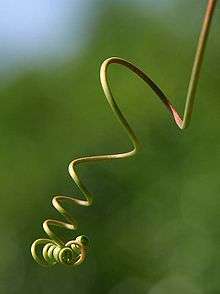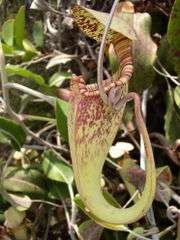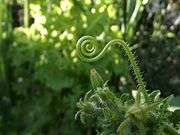Tendril
In botany, a tendril is a specialized stem, leaves or petiole with a threadlike shape that is used by climbing plants for support, attachment and cellular invasion by parasitic plants, generally by twining around suitable hosts found by touch. They do not have a lamina or blade, but they can photosynthesize. They can be formed from modified shoots, modified leaves, or auxiliary branches and are sensitive to chemicals, often determining the direction of growth, as in species of Cuscuta.[1]

History
The earliest and most comprehensive study of tendrils was Charles Darwin's monograph On the Movements and Habits of Climbing Plants, which was originally published in 1865. This work also coined the term circumnutation to describe the motion of growing stems and tendrils seeking supports. Darwin also observed the phenomenon now known as tendril perversion, in which tendrils adopt the shape of two sections of counter-twisted helices with a transition in the middle.[2]
Biology of tendrils
In the garden pea, it is only the terminal leaflets that are modified to become tendrils. In other plants such as the yellow vetch (Lathyrus aphaca), the whole leaf is modified to become tendrils while the stipules become enlarged and carry out photosynthesis. Still others use the rachis of a compound leaf as a tendril, such as members of the genus Clematis.
The specialised pitcher traps of Nepenthes plants form on the end of tendrils. The tendrils of aerial pitchers are usually coiled in the middle. If the tendril comes into contact with an object for long enough it will usually curl around it, forming a strong anchor point for the pitcher. In this way, the tendrils help to support the growing stem of the plant.[3] Tendrils of Cuscuta, a parasitic plant, are guided by airborne chemicals, and only twine around suitable hosts.
Self-discrimination
Although tendrils twine around hosts based on touch perception, plants have a form of self-discrimination[4] and will avoid twining around themselves - demonstrating chemotropism based on chemoreception.[5]
Gallery
 Nepenthes rafflesiana upper pitcher with coiled tendril.
Nepenthes rafflesiana upper pitcher with coiled tendril. Virginia Creeper vine beginning tendril
Virginia Creeper vine beginning tendril Cucumber tendril
Cucumber tendril(NRCS_Photo_Gallery).jpg) Squash vine coiled tendril
Squash vine coiled tendril
References
- "Plants: A Different Perspective". content.yudu.com. Archived from the original on 2017-02-17. Retrieved 2018-01-09.
- Charles Darwin, "On the movements and habits of climbing plants", Journal of the Linnean Society, 1865.
- Clarke, C.M. 1997. Nepenthes of Borneo. Natural History Publications, Kota Kinabalu.
- Fukano, Yuya; Yamawo, Akira (26 August 2015). "Self-discrimination in the tendrils of the vine is mediated by physiological connection". Proceedings of the Royal Society B: Biological Sciences. 282 (1814): 20151379. doi:10.1098/rspb.2015.1379. PMC 4571702. PMID 26311669. Archived from the original on 17 October 2017. Retrieved 16 October 2017.
- Fukano, Yuya (15 March 2017). "Vine tendrils use contact chemoreception to avoid conspecific leaves". Proceedings of the Royal Society B: Biological Sciences. 284 (1850): 20162650. doi:10.1098/rspb.2016.2650. PMC 5360923. PMID 28250182. Archived from the original on 17 October 2017. Retrieved 16 October 2017.
External links
- ExcitingNature.com - Tendril in Thigmotropism
